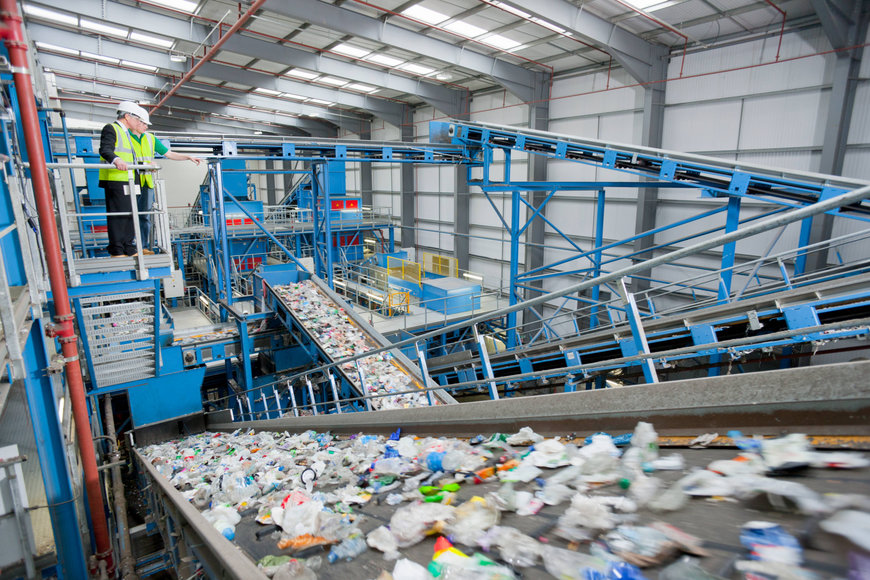www.industry-india.com
23
'23
Written on Modified on
Habasit News
Key considerations when selecting belt material in recycling
The pros and cons associated with the rubber, PVC and TPU conveyor belts that are commonly found in recycling plants.

Recycling plants are a natural home for conveyor belts, with these being used to process, sort, and transport waste materials plantwide. However, with multiple different conveyor belt types available, it can sometimes be difficult for plant managers to know which type is best for the job. Here Marcin Grzeszek, Manager Industry Segment Recycling at conveyor belt manufacturer Habasit, discusses the pros and cons of the three main types of conveyor belt materials found in recycling plants.
Conveyor belts are an essential part of any recycling operation. There are three main types of conveyor belt materials that are commonly used in recycling applications: rubber, PVC, and TPU. Each material has its own advantages and disadvantages, and the best material for a particular application will depend on a number of factors, including the type of materials being recycled, the speed of the conveyor belt, and the environmental impact of the material.
Rubber belts
Traditionally, rubber belts have been the first choice for use in recycling applications and are still widely used despite new materials becoming more readily available. Rubber belts have several key advantages, such as high mechanical strength, cut resistance, and abrasion resistance. These are particularly valuable for separating mixed waste, especially when materials like brick, concrete, glass, and steel are involved.
However, rubber belts have a couple of major disadvantages, including that they are slow to run and extremely energy intensive compared to other options. This is mainly caused by the high thickness and weight of rubber belts compared to alternative materials. For example, typical running speeds for a 3 m wide rubber belt are between 1 m/s and 1.5 m/s, whereas other materials can achieve speeds between 4 m/s and 6 m/s.
Because of their weight, larger pulleys are needed to drive rubber belts compared to similar sized belts made from lightweight materials.
PVC belts
Lightweight materials, such as Polyvinyl Chloride (PVC), are becoming increasingly more popular for applications like eddy current separators or general conveyors. PVC products are much lighter than conventional rubber belts and don’t require heavy construction of conveyor parts. They also consume less energy in operation.
The lower energy required to operate the system and lighter conveyor build lowers a facility’s ongoing operational costs and reduces its carbon footprint, something that is becoming a growing priority for many businesses.
While not as durable as rubber belts, PVC belts are well suited to transport materials like plastic and paper where there is less mechanical strain put on the belt than when transporting materials like brick and concrete. However, PVC does not work well if exposed to sunlight and very low temperatures, below -10oC.
TPU belts
Another alternative to rubber and PVC belts is Thermoplastic Polyurethane (TPU). Generally, TPU belts have the highest upfront costs out of the three materials, but a lower total cost of ownership.
TPU belts are lightweight, roughly half the weight of similar sized rubber belts, facilitating faster, wider recycling lines. This results in TPU belts having lower ongoing energy and maintenance costs compared to rubber belts while having an increased throughput.
However, TPU belts are not without their downsides. TPU is not as resistant to extremely hot water as PVC. This means that TPU belts are not well suited for applications involving a hot wash, such as the trommel separation of PET plastics where they are used to remove excess debris or labeling.
Choosing the right belt
The best way to choose the right conveyor belt material for your recycling operation is to consider the factors that are most important to you. If you are looking for a strong, durable belt that can handle a variety of materials, then a rubber belt may be the best choice. If you are looking for a lightweight, energy-efficient belt, then a PVC or TPU belt may be a better option.
No matter what material you choose, it is important to make sure that the belt is properly installed and maintained. This will help to ensure that the belt lasts for many years and that it performs at its best.
By engaging a knowledgeable conveyor partner, such as Habasit, recycling companies can rest assured that they are always using the most suitable material for the application. For more information, visit https://www.habasit.com/en/Industries/More-Industries/Waste-Treatment-and-Recycling.
www.habasit.com

